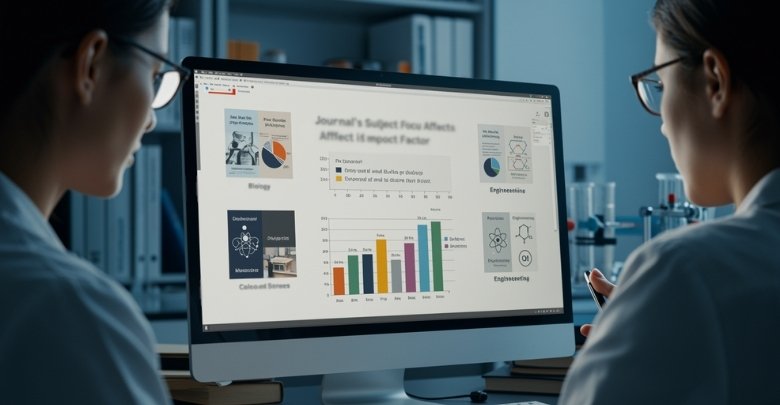Cell Reports Physical Science is a respected journal in the field, consistently publishing high-quality research in the physical sciences. Researchers often seek its latest impact factor to gauge its academic standing. This leads to the natural question: what is the impact factor of the cell reports physical science journal?
The impact factor of Cell Reports Physical Science is 7.9, reflecting its strong influence in the scientific community. The journal maintains high research quality, strict peer review, and global recognition, leading to frequent citations. Its accessibility and subject relevance contribute to its credibility and reputation in physical science research.
If you’re curious about how the impact factor is determined and why it matters, this article provides all the details you need. Keep reading to learn more about the journal’s credibility and its role in advancing scientific research.
What is the Impact Factor of the Cell Reports Physical Science Journal?
The impact factor of a journal is a crucial indicator of its influence on the academic community. It reflects how frequently its articles are cited in other research. For anyone following advancements in physical science, knowing a journal’s impact factor helps in identifying credible sources. Keep reading to explore the key factors behind its rating.
Research Quality
A high impact factor often signifies the quality of research published in a journal. Cell Reports Physical Science maintains rigorous peer-review standards, ensuring only well-researched and valuable studies are published. This attracts top researchers who trust the journal for its credibility and scientific integrity. With its current impact factor of 7.9, the journal has solidified its position among reputable scientific publications.
Citation Frequency
The impact factor is largely determined by the citations. When articles from a journal are frequently referenced in other studies, it indicates their significance in the field. The journal’s focus on publishing innovative research ensures that its content remains valuable to scientists. More citations mean greater visibility, reinforcing its role as a trusted source in the scientific community.
Editorial Standards
High academic standards are met by published content thanks to a well-organized editorial process. The editorial team of Cell Reports Physical Science consists of experienced professionals who carefully review submissions. This strict selection process helps maintain the journal’s credibility. By emphasizing accuracy, originality, and clarity, the journal consistently attracts high-quality research that contributes to its strong reputation.
Global Recognition
A journal’s reach across different countries affects its impact. With contributions from researchers worldwide, Cell Reports Physical Science has gained international recognition. It serves as a platform for scientists from diverse backgrounds, enhancing collaboration across institutions. This global influence ensures that its research remains relevant, widely cited, and applicable to various fields of physical science.
Subject Relevance
The impact factor also depends on how relevant a journal’s research is to current scientific challenges. Covering a broad range of topics in physical science, this journal ensures that its articles remain significant. Researchers often seek publications that address modern scientific concerns, and this journal’s focus on the latest discoveries keeps it at the forefront of academic discussions.
Accessibility
Open access and easy availability increase readership and citations. The more researchers can access and cite a journal’s work, the higher its impact factor tends to be. By offering accessible content, Cell Reports Physical Science broadens its influence and ensures that its research reaches as many scientists as possible. Increased accessibility strengthens its role in advancing scientific knowledge.
Research Funding
Well-funded studies often lead to high-quality publications, which in turn attract citations. Many articles in this journal come from research projects supported by major funding agencies. Access to proper funding allows scientists to conduct in-depth studies, produce reliable results, and publish in esteemed journals. The presence of well-supported research strengthens the credibility and impact of the journal’s content.
Conference Discussions
Academic conferences play a role in spreading research findings and influencing citation rates. With discussions around Cell Reports Physical Science happening at various events, including a few upcoming conferences, researchers get more opportunities to engage with its content. When findings presented at conferences gain attention, they often lead to more citations, further establishing the journal as a respected source in the field.
Competitive Field
The journal competes with many well-established publications in physical science. Standing out in a competitive field requires publishing groundbreaking studies. By maintaining a strong editorial process and selecting high-impact research, the journal continues to attract leading scientists. Its ability to remain relevant in an evolving scientific landscape makes it a preferred choice for researchers seeking a credible publishing platform.
It is easier to evaluate Cell Reports Physical Science’s credibility when one knows why it continues to have a significant impact factor. Many elements contribute to this rating, from research quality to citation frequency. Keeping track of such metrics is essential for anyone engaged in scientific research.
Why Researchers Prefer High Impact Factor Cell Reports Physical Science Journal?
Publishing in a well-regarded journal can significantly influence a researcher’s credibility and career growth. Cell Reports Physical Science is one such platform that has gained attention due to its high impact factor. Keep reading to learn more.
Strong Reputation
Researchers often seek journals that hold authority in their respective fields. Cell Reports Physical Science has built a solid reputation by consistently publishing high-quality, peer-reviewed articles. This credibility not only ensures widespread recognition but also helps researchers gain the trust of their peers, making their work more valuable in the scientific community.
High Visibility
Getting published is just one part of the process; making sure the research reaches the right audience is equally important. This journal offers extensive reach due to its association with a well-known publisher and its open-access model, ensuring that published research is accessible to scientists worldwide without paywall restrictions.
Fast Publication Process
Traditional publishing routes often take months or even years before an article sees the light of day. This journal streamlines the review and publication process, allowing researchers to share their findings without unnecessary delays. A faster publication timeline ensures that research remains relevant and contributes to ongoing scientific discussions.
Strong Peer-Review System
A careful review process is crucial for maintaining scientific integrity. This journal ensures that all submissions go through a high-standard peer-review process conducted by field experts. Constructive feedback and thorough evaluations help refine research quality, making sure that only impactful studies make it to publication.
Better Citation Potential
Citations play a key role in a researcher’s academic influence. Since Cell Reports Physical Science has a high impact factor, published articles have a greater chance of being cited by fellow scientists. A higher citation count boosts a researcher’s profile, increases funding opportunities, and enhances career prospects in academia and beyond.
Academic success can be influenced by the journal a researcher chooses. With its high reputation, broad visibility, efficient publishing process, strict peer reviews, and strong citation potential, Cell Reports Physical Science remains a preferred choice for many researchers looking to make a meaningful impact in their fields.
How Can Researchers Assess the Credibility of High-impact Journals?
It is essential for researchers who want to publish or cite trustworthy studies to assess the legitimacy of high-impact journals. Not all journals with a high impact factor maintain rigorous publishing standards, making it essential to evaluate them carefully. Let’s break down the key ways to assess their credibility.
Publisher Reputation
A journal’s publisher plays a big role in its credibility. Well-known academic publishers like Elsevier, Springer, and Wiley follow strict peer-review processes. If a journal is associated with a reputable organization, it’s a good sign. On the other hand, unknown or controversial publishers may indicate lower reliability.
Indexing in Databases
Legitimate high-impact journals are usually indexed in recognized academic databases. For example, researchers often rely on indexing platforms like Web of Science and Scopus. In fact, using Scopus for research impact can help determine how well a journal’s studies contribute to the academic field, ensuring its credibility.
Peer-Review Process
A strong peer review process ensures that published research meets high academic standards. Journals with double-blind peer reviews are generally more trustworthy since both authors and reviewers remain anonymous. If a journal lacks clear peer-review policies or has a fast acceptance rate, it might not be credible.
Editorial Board Members
The presence of qualified and respected scholars on a journal’s reviewing board is a sign of legitimacy. Reputable journals feature editors with strong academic backgrounds and relevant expertise. If the editorial board lacks transparency or consists of unknown researchers, it raises concerns about the journal’s credibility.
Citation and Impact Factor
Impact factors and citation counts can give insights into a journal’s influence. However, not all high-impact journals maintain ethical publishing practices. Some manipulate citation metrics to appear more credible. Cross-checking citation trends and reading published articles can help verify whether a journal’s impact is genuine.
Assessing a journal’s credibility is essential before citing or submitting research. Factors like indexing, peer review, and publisher reputation all play a role. By taking the time to verify these aspects, researchers can ensure they rely on trustworthy sources for their academic work.
Why Researchers Prefer High Impact Factor Cell Reports Physical Science Journal?
Publishing in a respected journal can shape a researcher’s career by increasing recognition and credibility. Cell Reports Physical Science has gained attention for its high impact factor, attracting researchers from various fields. Let’s explore the key reasons behind its popularity.
Strong Academic Influence
A journal’s impact factor directly reflects the quality and relevance of its published work. Since Cell Reports Physical Science consistently publishes high-impact studies, researchers gain credibility when their work appears on its pages. Being cited in a journal of this caliber strengthens a researcher’s authority in their field, making their work more valuable to other scientists and institutions worldwide.
Broad Global Reach
Visibility is crucial for research impact, and this journal ensures widespread accessibility through its open-access model. With a global readership, articles published here are more likely to be referenced by scientists, industry professionals, and educators. This broad exposure increases the chances of collaboration and future research opportunities, giving researchers a greater platform to share their findings with the world.
Fast and Transparent Publishing
Delays in publishing can limit the relevance of new research, but this journal offers a streamlined submission and review process. The fast turnaround time ensures that groundbreaking findings reach the scientific community without unnecessary delays. At the same time, transparency in the review process ensures fairness, helping authors understand and improve their work before publication.
Strict Peer Review
Publishing in a high-impact journal requires passing a strict peer-review process. This journal follows a detailed evaluation system where experts assess research for accuracy, originality, and significance. Constructive feedback from reviewers helps improve the quality of submissions, ensuring that only well-researched and scientifically sound studies get published, ultimately enhancing the credibility of both the author and the journal.
Higher Citation Opportunities
A major reason researchers chose this journal is its high citation rate. Since it is widely read and respected, articles published here attract more citations compared to those in lower-impact journals. Higher citations boost a researcher’s academic profile, increasing opportunities for funding, collaboration, and career advancement while contributing to the overall progress of their field.
Selecting the right journal is essential for maximizing research impact. With its strong reputation, extensive reach, efficient publishing process, strict peer review, and high citation potential, Cell Reports Physical Science stands out as a preferred choice for researchers looking to enhance their academic influence and contribute to meaningful scientific advancements.
How Does a Journal’s Subject Focus Affect Its Impact Factor?
Not all academic journals have the same influence, and their subject focus plays a huge role in determining their impact. Some fields naturally attract more citations than others, making it easier for journals in those areas to rank higher. Understanding how this works can help researchers make informed decisions about where to publish. Let’s explore the key factors affecting impact factors.
Citation Trends Vary by Field
Different academic fields have different citation patterns. For example, medical and life sciences often see higher citation rates than niche disciplines like philosophy. This happens because some research areas produce findings that are widely used across multiple disciplines, leading to more citations over time.
Niche Journals vs. Broad-Scope Journals
Specialized journals focus on specific areas, attracting a dedicated readership but often receiving fewer citations overall. On the other hand, journals covering broad topics appeal to a wider audience, increasing their citation potential. Researchers aiming to enhance their visibility should consider the balance between specialization and reach when choosing a journal.
Publication Frequency and Impact
Journals that publish more frequently often have a higher impact factor. Regular publications keep research active and relevant, increasing the chances of citations. However, quality still matters more than quantity. A journal that maintains strong peer review standards while publishing frequently will see more recognition in the academic world.
Quality Assessment is Important
While the impact factor is a crucial metric, it doesn’t always reflect the true quality of research. Many scholars focus on evaluating research quality before submitting their work, as this helps ensure it meets high academic standards. A well-reviewed, well-cited study in a lower-impact journal can sometimes be more valuable than a poorly reviewed one in a high-impact journal.
Accessibility Affects Citations
Open-access journals tend to get cited more because they allow free access to research. When more people can read a study without paywalls, it increases the likelihood of citations. Researchers looking to boost their work’s visibility often consider whether a journal is open-access before deciding where to submit.
A journal’s subject focus directly influences its impact factor, but other factors like accessibility, publication frequency, and audience reach also matter. Understanding these elements can help researchers make strategic publishing choices. When selecting a journal, thinking beyond just the impact factor can lead to better long-term benefits.
FAQs About What is the Impact Factor of the Cell Reports Physical Science Journal?
Understanding a journal’s impact factor can help researchers make informed publishing choices. Cell Reports Physical Science is a well-regarded journal in the field of physical science, but many still have questions about its ranking and influence. Below, we answer some commonly asked questions to clarify its impact factor and significance.
How Is the Impact Factor of a Journal Calculated?
The impact factor of a journal is determined by dividing the number of citations received by articles published in the journal over two years by the total number of articles published in the same period. This metric helps gauge the journal’s influence and the relevance of its published research.
Why Does the Impact Factor of a Journal Change Over Time?
A journal’s impact factor is updated annually based on the latest citation data. Factors like an increase in high-quality publications, greater research relevance, and evolving citation trends contribute to fluctuations. A growing interest in a particular research field can also positively impact citation rates and influence the journal’s score.
How Does the Impact Factor of Cell Reports Physical Science Compare to Other Journals?
With an impact factor of 7.9, Cell Reports Physical Science holds a strong position in the field of physical science. While some journals in broader scientific categories may have higher impact factors, this journal is well-regarded for its rigorous peer review, high citation rates, and contribution to cutting-edge discoveries in physical science.
Does the Impact Factor Reflect the Quality of Research in the Journal?
The impact factor is a useful metric, but it does not always fully represent research quality. While high-impact journals tend to publish influential studies, individual article quality varies. Peer review, research significance, and author credibility are equally important in evaluating the true value of any published work.
How Does Open Access Influence the Impact Factor of a Journal?
Open-access journals tend to receive more citations since they are freely available to researchers worldwide. Cell Reports Physical Science follows an accessible publishing model, which increases readership and citation opportunities, contributing to its strong impact factor in the scientific community.
Can a Researcher Improve Their Work’s Citation Potential by Publishing Here?
Yes, publishing in Cell Reports Physical Science can increase a researcher’s citation count due to its broad readership and credibility. However, the number of citations depends on factors like research originality, topic relevance, and how widely the study is referenced in subsequent academic work.
What Role Does the Editorial Board Play in Maintaining the Impact Factor?
The editorial board ensures that only high-quality, peer-reviewed research is published. Their expertise in selecting relevant and scientifically sound studies helps maintain the journal’s credibility, attracting more citations and ultimately contributing to a stable or increasing impact factor.
Are There Any Limitations to Using the Impact Factor as a Measure of a Journal’s Importance?
While the impact factor is widely used, it has limitations. It favors fields with high citation rates and may not accurately represent journals in niche areas. Additionally, some highly valuable research may not receive immediate citations, affecting the impact factor despite the study’s long-term significance.
How Can Early-Career Researchers Benefit from Publishing in a High-Impact Journal?
Publishing in a journal with a strong impact factor enhances a researcher’s academic profile, making it easier to secure funding, collaborations, and career opportunities. For early-career scientists, having research published in a reputable journal like Cell Reports Physical Science can provide visibility and establish credibility in their field.
Does the Impact Factor Affect a Journal’s Acceptance Rate?
Yes, high-impact journals typically have lower acceptance rates due to their strict selection criteria. Since these journals receive numerous submissions, only the most well-researched and innovative studies are accepted. This competitive nature ensures that published research maintains a high standard and continues to attract citations.
Bottom Line
A journal’s impact factor plays a big role in how its research is perceived. Cell Reports Physical Science stands out for its strong editorial standards, global reach, and high citation rates. For those wondering, what is the impact factor of the Cell Reports Physical Science Journal? It currently holds a solid impact factor of 7.9, reflecting its credibility in the scientific world.
If you’re considering submitting your work, focus on research originality, clarity, and relevance to improve acceptance chances. Staying updated with citation trends and choosing the right journal can boost your academic influence. Keep striving for excellence, and best wishes for your research career ahead!








